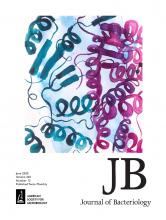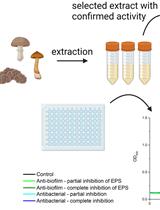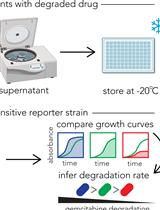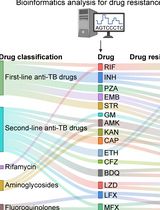- EN - English
- CN - 中文
Rapid Isolation and Purification of Secreted Bacteriocins from Streptococcus mutans and Other Lactic Acid Bacteria
变形链球菌及其他乳酸菌分泌细菌素的快速分离纯化
发布: 2020年11月20日第10卷第22期 DOI: 10.21769/BioProtoc.3824 浏览次数: 6389
评审: Alba BlesaSimab KanwalChenchen Liu
Abstract
Bacteriocins are small ribosomally synthesized antimicrobial peptides produced by some microorganisms including lactic acid bacteria (LAB), a group of Gram-positive bacteria (cocci, rods) expressing high tolerance for low pH. Bacteriocins kill bacteria rapidly and are biologically active at very low concentrations. Bacteriocins produced by LAB are primarily active against closely related bacterial species. Many bacteriocins have been investigated with respect to their potential use in promoting human, plant, and animal health, and as food biopreservatives. Bacteriocins produced by LAB are particularly interesting since several LAB have been granted GRAS (Generally Recognized as Safe) status. Because it is not always possible to extract active bacteriocins secreted from cells grown in liquid medium, we developed a simple and inexpensive peptide extraction procedure using a semi-solid nutrient-rich agar medium. We hereby present a detailed procedure that leads to the rapid extraction of secreted bioactive bacteriocin peptides from the oral species Streptococcus mutans, a prolific bacteriocin-producing species, and its potential application for bacteriocin extraction from other LAB (e.g., Streptococcus, Lactococcus, Enterococcus). We also present a simple method for the detection of bacteriocin activity from the purified extracellular peptide extract.
Keywords: Bacteriocin (细菌素)Background
Most bacteria in nature do not exist independently but persist in complex multispecies biofilm communities (López et al., 2010). Numerous physical and nutritional interactions exist between bacteria contributing to the biofilm growth and survival. The production and secretion of bacteriocins to the extracellular space confer a distinct ecological advantage to the producer in competing against other bacteria that are present in the same ecological niche (Donia and Fischbach, 2015). Therefore, bacteria tightly regulate expression of bacteriocins to foster survival of the species within the biofilm.
The cariogenic organism Streptococcus mutans is found in the dental plaque, a biofilm community that forms on the tooth surface (Kolenbrander et al., 2010). Under normal circumstances, the dental plaque remains relatively stable (microbial homeostasis), contributing to dental health. However, a change in local environmental conditions can disrupt this natural homeostasis, leading to an ecological pressure that can cause disease. S. mutans is one of the most prolific producers of bacteriocins (referred to as mutacins) and bacteriocin production is considered to be an important factor in the colonization and establishment of S. mutans in the dental biofilm (Merritt and Qi, 2012). In our previous publications, we highlighted the role of S. mutans bacteriocins in the antagonistic interactions among oral streptococci (Dufour and Lévesque, 2013; Dufour et al., 2020 ). We also showed that DNA uptake and bacteriocin production were controlled by a tighty regulated quorum sensing system suggesting that DNA exchange could be enhanced by bacteriocin secretion during the state of genetic competence (Perry et al., 2009a and 2009b; Dufour et al., 2011).
Most strains of S. mutans encode bacteriocins. Identification of putative bacteriocins can be easily done in silico by screening of genomic DNA sequences. For instance, the freely available software BAGEL4 (http://bagel4.molgenrug.nl) can be used for the detection of putative bacteriocin genes. It also analyzes the surrounding region on the bacterial genome for genes possibly encoding proteins involved in transport, immunity, and regulation. However, the putative bacteriocin loci identified in silico do not necessarily represent functional bacteriocin production. Consequently, bacteriocins must be extracted and purified in order to study them. Only few bacteriocins produced by S. mutans have been purified and characterized (Nicolas et al., 2007). This may be due to the many challenges associated with the production and extraction of these extracellular peptides. High variability of peptide recovery from one extraction to another is also usually observed. Since the volumetric bacteriocin production is dependent on the total biomass production, a nutrient-rich medium (e.g., animal tissue extracts) is also suggested for efficient production. In this protocol, we developed an extraction method from submerged cultures using a commercial medium supplemented with mineral salts and yeast extract (Dufour et al., 2020). This procedure has been successfully used by our group to extract biologically active bacteriocin peptides from oral streptococci (S. mutans, S. salivarius) isolated from the dental plaque biofilm of caries-free and caries-active subjects.
Materials and Reagents
Sterile 13 ml culture tube with ventilation cap (any type, e.g., Sarstedt, catalog number: 62.515.006 )
Screw cap tube 50 ml (any type, e.g., Sarstedt, catalog number: 62.547.205 )
Disposable glass Pasteur pipets 22.9 cm (9”) (e.g., VWR, catalog number: 89061-526 )
Disposable syringe, 50 ml (any type, e.g., Thermo Fisher Scientific, Fisherbrand, catalog number: 14-823-43 )
Acrodisc® syringe filters with Supor® membrane 0.2 µm, 25 mm (Pall Corporation, catalog number: 4506 )
Petri dishes with clear lid 100 x 15 mm (any type, e.g., Thermo Fisher Scientific, Fisherbrand, catalog number: FB0875712 )
Aluminum foil (any product)
Bacteriocin-producing LAB (e.g., Streptococcus, Lactococcus, Enterococcus)
Bacterial target strain: Micrococcus luteus (e.g., strain ATCC 4698)
Dehydrated Todd-Hewitt broth (Thermo Fisher Scientific, BD Difco, catalog number: DF0492-17-6 )
Dehydrated Columbia broth (Thermo Fisher Scientific, BD Difco, catalog number: DF0944-17-0 )
Yeast extract (BioShop Life Science Products, catalog number: YEX401 )
Agar (BioShop Life Science Products, catalog number: AGR001 )
NaH2PO4 (e.g., Millipore Sigma, catalog number: S8282 )
Na2HPO4 (e.g., Millipore Sigma, catalog number: S9763 )
MgSO4 (e.g., Millipore Sigma, catalog number: M7506 )
FeSO4 (e.g., Millipore Sigma, catalog number: F7002 )
CaCO3 (e.g., Millipore Sigma, Sigma-Aldrich, catalog number: C4830 )
Chloroform ACS Reagent Grade (Caledon Laboratory Chemicals, catalog number: 3000-1-40 )
Acetonitrile (for HPLC) (Thermo Fisher Scientific, Fisher Chemical, catalog number: A998 )
Trifluoroacetic acid (Peptide and Protein Analysis/Certified) (Thermo Fisher Scientific, Fisher Chemical, catalog number: O4902 )
Methanol (for HPLC) (Thermo Fisher Scientific, Fisher Chemical, catalog number: A452SK-4 )
Hydrochloric acid solution, 6 N ACS (Certified) (Thermo Fisher Scientific, Fisher Chemical, catalog number: SA56-4 )
Milli-Q water or any filtered ultra-pure water
THYE broth (500 ml) (see Recipes)
BAC semi-solid agar medium (2 L) (see Recipes)
Columbia-CaCO3 agar plates (500 ml) (see Recipes)
Columbia soft agar (500 ml) (see Recipes)
ACN-TFA solvent (500 ml) (see Recipes)
Methanol:water, 95:5 v/v [pH 2] (500 ml) (see Recipes)
Methanol:water v/v gradient (500 ml) (see Recipes)
Equipment
Heavy-duty low form beaker 4 L (any type, e.g., VWR, catalog number: 10536-520 )
Heavy-duty low form beaker 250 ml (any type, e.g., VWR, catalog number: 10536-390 )
Scoop type spatula (any type, e.g., VWR International, catalog number: 470149-438 )
Centrifuge bottles 250 ml (Thermo Fisher Scientific, Nalgene PPCO, catalog number: 3120-0250 )
Reusable glass media bottle with cap 1 L (any type, e.g., Thermo Fisher Scientific, Fisherbran, catalog number: FB8001000 )
Reusable glass media bottle with cap 500 ml (any type, e.g., Thermo Fisher Scientific, Fisherbrand, catalog number: FB800500 )
Sep-Pak® C18 environmental cartridges, 55-105 µm (Waters, catalog number: WAT023635 )
CO2 incubator (any type, e.g., Thermo Fisher Scientific, model: Hera Cell 150 )
Water bath (any product)
Magnetic stirrer (any product)
Magnetic stir bar (any product)
Benchtop refrigerated centrifuge (any type, e.g., Eppendorf, model: 5810 R )
Floor refrigerated centrifuge (any type, e.g., Beckman Coulter, model: J2-21 M )
Ultra-low temperature freezer (any product, e.g., Thermo Fisher Scientific, model: Forma 900 Series )
SpeedVac vacuum concentrator (any product, e.g., Thermo Fisher Scientific, model: Savant SPD120 )
Portable pump (any product, e.g., Bio-Rad, model: Econo Gradient Pump )
Bunsen burner
Cold (4 °C) lab chamber
Lab fume hood
Steam autoclave
Procedure
文章信息
版权信息
© 2020 The Authors; exclusive licensee Bio-protocol LLC.
如何引用
Cheng, M., Gong, S. and Lévesque, C. M. (2020). Rapid Isolation and Purification of Secreted Bacteriocins from Streptococcus mutans and Other Lactic Acid Bacteria. Bio-protocol 10(22): e3824. DOI: 10.21769/BioProtoc.3824.
分类
微生物学 > 抗微生物试验 > 抗细菌试验
生物化学 > 其它化合物 > 肽
您对这篇实验方法有问题吗?
在此处发布您的问题,我们将邀请本文作者来回答。同时,我们会将您的问题发布到Bio-protocol Exchange,以便寻求社区成员的帮助。
Share
Bluesky
X
Copy link














